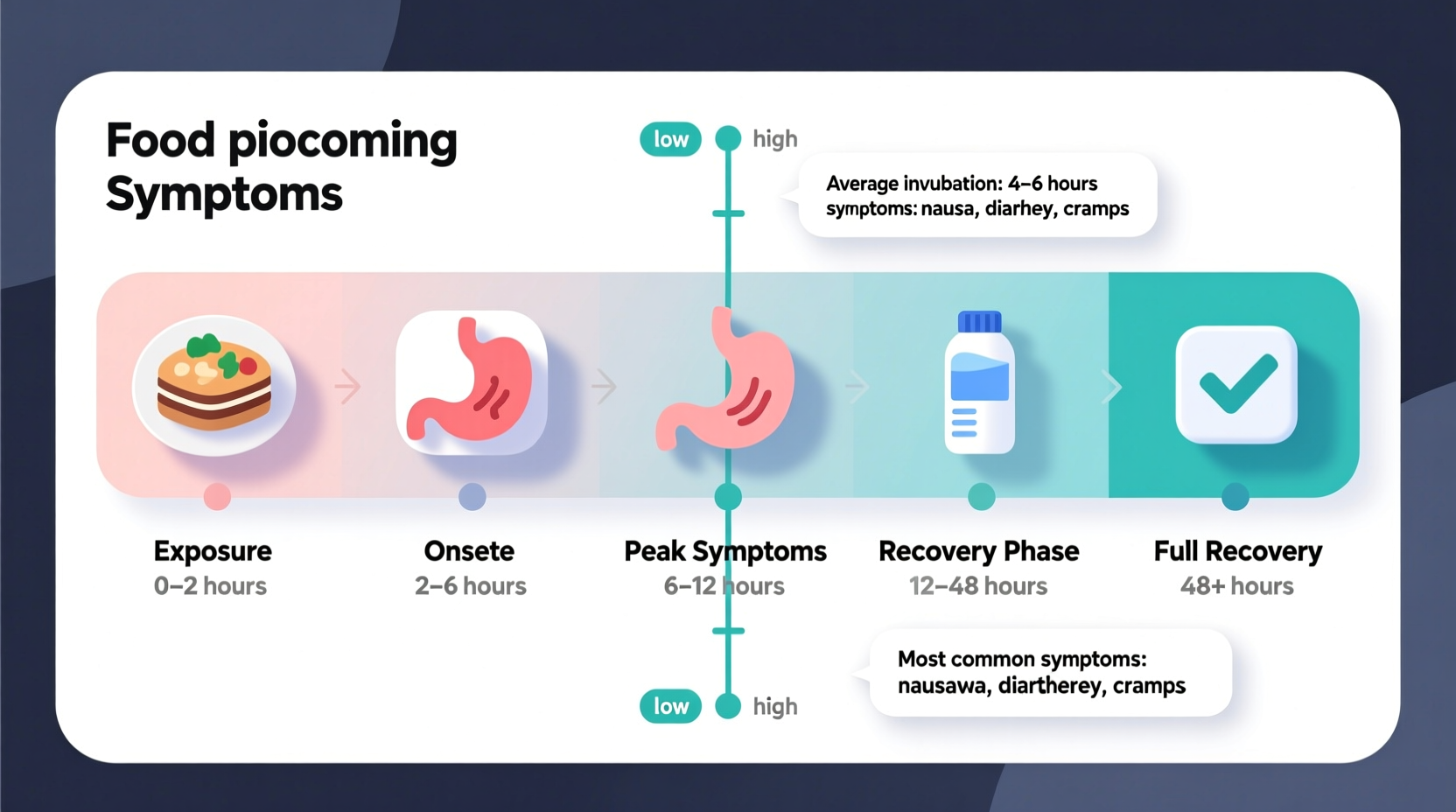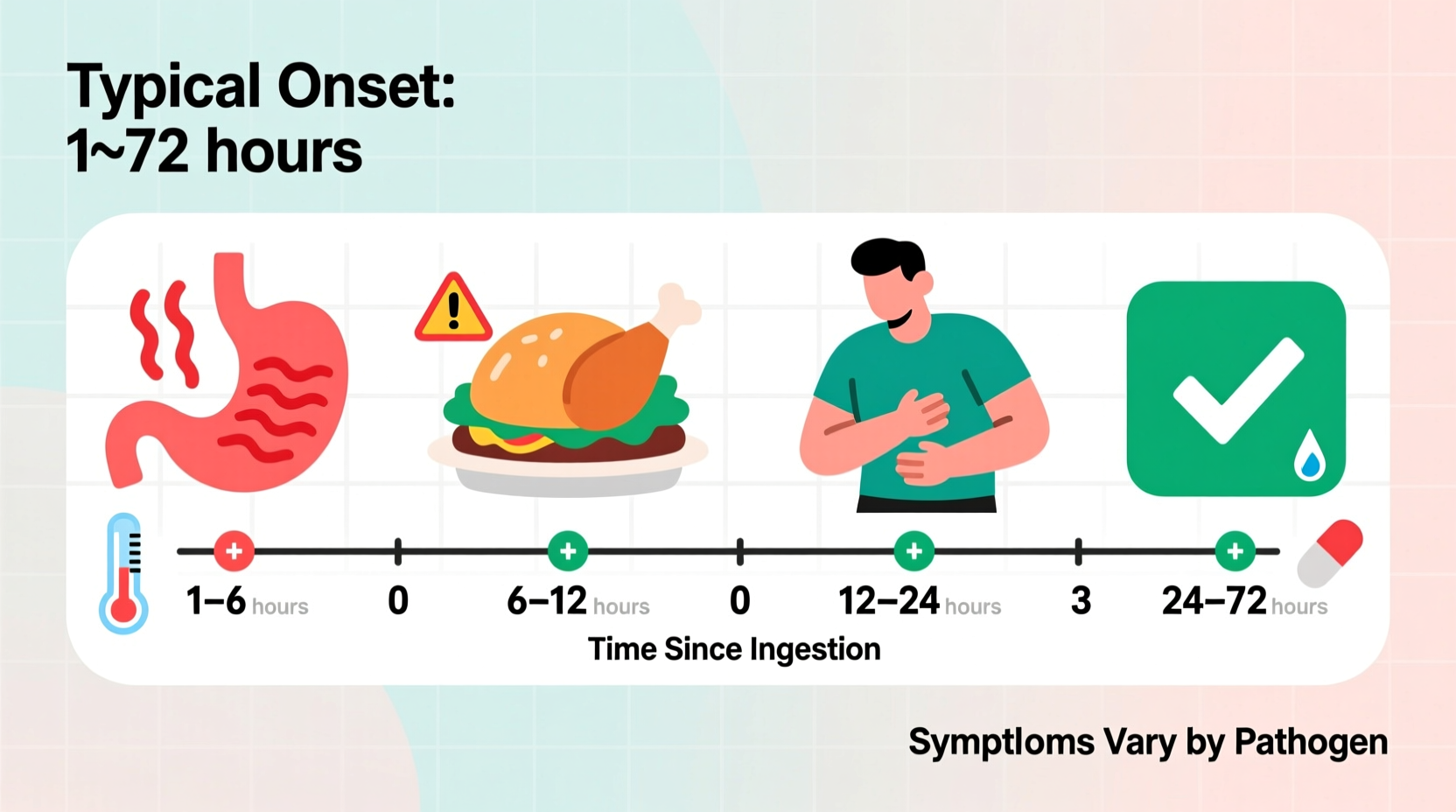Waking up with sudden nausea and wondering when did this start? You're not alone. Each year, 1 in 6 Americans experience foodborne illness, and knowing the timeline could mean the difference between managing symptoms at home or heading to the emergency room. This guide delivers precise onset windows for 12 common pathogens, backed by CDC surveillance data, so you can make informed decisions when every hour counts.
Decoding Your Food Poisoning Timeline: Pathogen-Specific Onset Windows
Food poisoning isn't one-size-fits-all. Different contaminants follow distinct biological pathways that determine symptom onset. Understanding these patterns helps identify the likely culprit and appropriate response.
| Pathogen | Typical Onset Time | Common Sources | Duration |
|---|---|---|---|
| Staphylococcus aureus | 30 min - 8 hours | Deli meats, salads, pastries | 1-2 days |
| Bacillus cereus (vomiting type) | 1-6 hours | Fried rice, pasta dishes | 6-24 hours |
| Salmonella | 6-72 hours (avg 12-36) | Raw eggs, poultry, produce | 4-7 days |
| E. coli O157:H7 | 1-10 days (avg 3-4) | Undercooked beef, leafy greens | 5-10 days |
| Botulism | 12-36 hours (can be 6h-10d) | Home-canned goods, fermented fish | Weeks to months |
| Hepatitis A | 15-50 days (avg 28) | Contaminated water, shellfish | 2-7 weeks |
This CDC-verified food poisoning incubation chart reveals critical patterns. According to CDC surveillance data, bacterial toxins like Staphylococcus act fastest because they've already multiplied in food before consumption. In contrast, pathogens requiring intestinal colonization (like Salmonella) need time to reproduce before causing symptoms.

Your Body's Response Timeline: What's Happening Internally
That unsettling feeling didn't happen overnight. Here's the biological sequence determining your symptom onset:
- 0-30 minutes: Rapid-acting toxins (staph, Bacillus cereus) trigger immediate histamine release
- 1-6 hours: Preformed toxins reach critical concentration, activating vomiting centers
- 6-24 hours: Bacteria like Salmonella multiply to infectious dose (10,000+ organisms)
- 24-72 hours: Pathogens invade intestinal lining, triggering inflammation response
- 3+ days: Parasites like Giardia establish infection through cyst development
Individual factors significantly alter these windows. FDA research shows that children, elderly, and immunocompromised individuals often experience accelerated onset due to less robust gut microbiomes. Conversely, healthy adults with strong stomach acid may delay symptoms by several hours.
Actionable Guidance Based on Your Symptom Timeline
Don't waste precious time guessing. Match your experience to these evidence-based response protocols:
If symptoms began within 6 hours
This suggests preformed toxins (staph, Bacillus cereus). Focus on hydration with electrolyte solutions—avoid anti-diarrheal medications as they trap toxins. Contact poison control if neurological symptoms appear. Document all consumed foods from the past 24 hours for potential outbreak reporting.
If symptoms began 6-24 hours after eating
Most likely Salmonella or norovirus. Continue hydration, monitor fever patterns, and isolate to prevent transmission. The Mayo Clinic recommends tracking symptom frequency—more than 6 watery stools in 24 hours warrants medical evaluation.
If symptoms began 1-3 days later
Could indicate E. coli or Campylobacter. Immediately stop consuming dairy products which can worsen symptoms. Watch for bloody stools or reduced urine output—these require urgent care. Preserve food samples if possible for pathogen identification.
When Standard Timelines Don't Apply: Critical Exceptions
While the 6-24 hour window covers most cases, these scenarios alter expected patterns:
- Low stomach acid conditions: Proton pump inhibitor users may experience delayed onset (up to 72 hours) for acid-sensitive pathogens
- Massive contamination events: Consuming extremely high pathogen loads can trigger symptoms in under 2 hours regardless of typical timelines
- Secondary infections: Some pathogens like Listeria can remain dormant for weeks before causing illness
Immunocompromised individuals should seek care immediately regardless of onset time. The World Health Organization emphasizes that foodborne illnesses cause 420,000 deaths globally each year—prompt intervention saves lives.
Prevention Strategies Targeted to Pathogen Timelines
Understanding onset windows informs smarter food safety practices:
- For fast-acting toxins: Never leave cooked rice or pasta at room temperature >2 hours—Bacillus spores germinate rapidly
- For mid-range pathogens: Use separate cutting boards for produce and proteins to prevent Salmonella cross-contamination
- For delayed-onset illnesses: Wash all produce under running water—even pre-washed greens can harbor E. coli
Temperature control remains your strongest defense. The FDA's "Danger Zone" guidelines specify keeping cold foods below 40°F and hot foods above 140°F to prevent pathogen multiplication.
When to Seek Immediate Medical Attention
Don't wait for textbook timelines if you experience:
- Signs of dehydration (dry mouth, reduced urination, dizziness)
- Fever above 101.5°F lasting more than 24 hours
- Bloody stools or vomit
- Neurological symptoms (blurred vision, muscle weakness)
- Symptoms persisting beyond 72 hours
For vulnerable populations—infants, elderly, pregnant women, and immunocompromised individuals—seek care at the first sign of illness regardless of onset time. Early antibiotic intervention can prevent complications from pathogens like Listeria.











 浙公网安备
33010002000092号
浙公网安备
33010002000092号 浙B2-20120091-4
浙B2-20120091-4